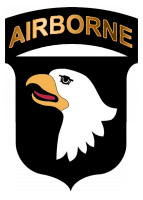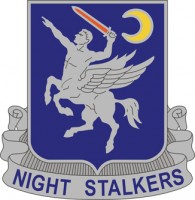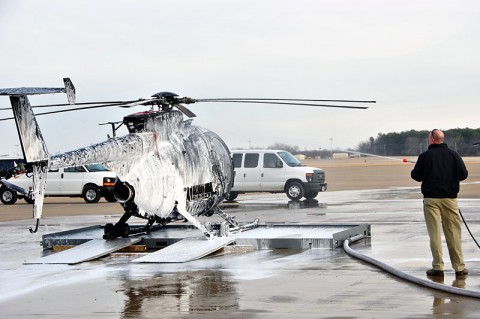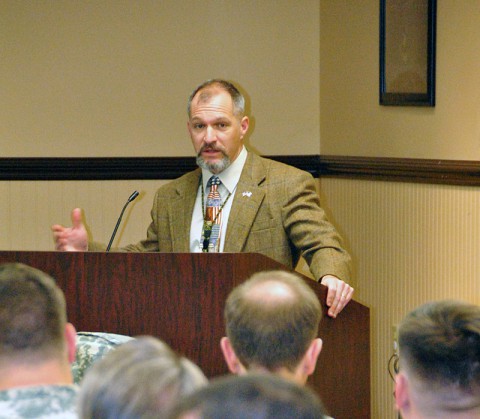Written by Staff Sgt. Thaddius S. Dawkins II
USASOAC Public Affairs

 Fort Campbell, KY – The United States Army Special Operations Aviation Command held a corrosion symposium at the 160th Special Operations Aviation Regiment (Airborne)’s compound in hopes of solving a problem that plagues every unit in the Army; corrosion.
Fort Campbell, KY – The United States Army Special Operations Aviation Command held a corrosion symposium at the 160th Special Operations Aviation Regiment (Airborne)’s compound in hopes of solving a problem that plagues every unit in the Army; corrosion.
The symposium took place over two days and covered the damaging effects corrosion has on the Army and the military as a whole. It also gave the attendees the opportunity to put names with the faces they could be working with to solve the problem.

The idea for the symposium came about following a recommendation from Brig. Gen. Clayton M. Hutmacher, commanding general, USASOAC.
“During a staff meeting at the USASOAC headquarters, Brig. Gen. Hutmacher had been briefed on the issue of corrosion,” said Morgan. “He looked at the G4’s aviation maintenance support office director, Lt. Col. Matt Isaacson, and told him ‘this is a problem and I want you to host a symposium on it.’ From there, Lt. Col Isaacson was exactly what he’s been since he began his tenure in the Regiment back in 2003, an absolute leader. He cast the vision and kept our office on course.”

While going through the legal and command approval process, Isaacson and Morgan also began building their invitation list.
“Our primary audience included decision-makers at the following levels: Army Aviation brigades in corrosive environments, Army Aviation and Special Operations materiel developers, policy-makers across the Department of Defense, and industry representatives knowledgeable about available materiel solutions to corrosion concerns,” said Isaacson.
“Steve Carr and his staff at the Army Aviation and Missile Command Corrosion Office and Rich Hayes, the Office of the Under Secretary of Defense’s corrosion policy and oversight deputy director, assisted us in focusing on a target audience of influential members,” he said. “After that, we were able to open up the invite to our brothers and sisters in arms from adjoining units. We feel that it is imperative that we approach this issue holistically as a DoD issue and with a ‘one team, one fight’ approach. Otherwise, by attacking it individually, each unit wastes valuable resources reinventing the same wheel.”
Don R. Duran, task order project lead for Camber Corporation’s Aviation Acquisition Support Division, said he believed an Army corrosion symposium was long overdue and commended USASOAC on their efforts.
“I’ve been dealing with Army corrosion now for over five years, and what I am taking away from this symposium is that there is one single point, which is now at the 160th’s Center of Excellence for Corrosion, that’s going to be the one central point to lead the Army in its overall intent to reduce corrosion,” he said. “It’s fantastic that these folks hosted us and that we’ve received the amount of information that we have. It’s great to see there are a lot of initiatives that they’ve taken into consideration.”
Isaacson said USASOAC’s continued emphasis on corrosion prevention and the fight ahead is something USASOAC doesn’t take lightly.
“We take corrosion prevention seriously for a variety of reasons,” he said. “First and foremost is safety. It is also important to remember that we have small teams of aircraft continuously deployed worldwide. It is incumbent upon us to ensure that when one of the few spare parts we have on hand is pulled out of a can, it’s serviceable.”
“What makes USASOAC’s program so good is that we control every element of our Special Operations Aviation unique supply processes,” Isaacson explained.
“Even when we’re doing things that they don’t necessarily understand, or things that aren’t ‘sexy,’ they give us maintainers the trust, resources and opportunity to do what we need to do,” he said.
It was clear during the symposium that USASOAC’s Corrosion Prevention Program is on the right path to making big changes in how the Special Operations Aviation community and the Army will look at combatting it in the future. Morgan hopes other units in need of assistance will reach out to their office and other subject matter experts to assist in solving the billion dollar problem.
“The symposium is over, but the battle is not,” he said. “If we can continue to be of assistance to other units, they are more than welcome to contact us. Steven Blasey is the USASOAC Corrosion Program Deputy. Our long time partners in this effort at the AMCOM Corrosion Office are great points-of-contact as well.”



Corrosion is a pervasive problem that costs 3% or more of GDP for most developed nations.
Corrosion is a global problem that has plagued buildings, monuments, equipment, and infrastructure for centuries. Every day scientists, researchers, chemists, engineers, and other professionals create revolutionary solutions to combat corrosion and protect vital assets from the damaging effects of corrosion-related deterioration and failure. In working with folks in the military packaging industry, I know the importance of being pre-emptive when it comes to corrosion prevention or else you could wind up spending a lot more than you’d like.
Than Nguyen
http://www.protectivepackaging.net/military-packaging